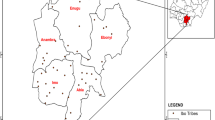Abstract
The effect of cooking on the proximate composition, energy value, ascorbic acid content and selected mineral levels of six edible vegetable leaves used in the preparation of Nigerian diets was investigated. In raw samples, moisture content ranged from 70.69 ± 8 0.15% in hard leaf (HL) to 93.29 ± 0.11% in water leaf (WL). Fluted pumpkin leaf (FPL) had the highest ash content of 5.91 ± 0.05% followed by HL (3.20 ± 0.33%); ash was lowest (1.22 ± 0.07%) in water leaf (WL). Protein was highest (5.3 2 ± 0.05%) in green leaf (GL) followed by HL (4.87 ± 0.08%) then BL (4.40 ± 0.24%) and was lowest in WL (1.68 ± 0.31%). For crude fat, the order was Oha leaf (OL) > FPL > GL > BL > WL > HL. Total carbohydrate was low in all the samples and was lowest in WL (3.09 ± 0.31%) with the highest value of 20.85 ± 0.24% in HL. The low caloric values in raw samples, which ranged from 25.6 in WL to 106.4 kcal/100 g sample in HL, indicate that these edible leaves are not good sources of crude fat, crude protein and total carbohydrate. Heat processing did not significantly (p > 0.05) affect moisture content but generally decreased ash, crude protein and crude fat though the decrease was not significant. Cooking decreased the ascorbic acid content of all the edible leafy vegetables investigated. Loss in ascorbic acid to the cooking water ranged from 7.61% in HL to 96.0% in BL. Results indicate that the vegetables analyzed were good sources of sodium, magnesium, iron, zinc and copper. Cooking decreased the level of the divalent minerals Mg, Fe, Zn and Cu but increased that of the monovalent metal Na in all the edible leafy vegetables investigated.
Similar content being viewed by others
References
Eheart MI, Odland D (1946) Storage effect on fresh broccoli and green beans. J Am Diets Association 60: 402–413.
Hutchinson J, Dalziel JM (1966) Flora of West Tropical Africa: Cucurbitaceae. Crown Agents for Overseas Government, London, 3rd ed, pp 181–185.
Onyeike EN, Onwuka O (1999) Chemical composition of some fermented vegetable seeds used as soup condiments in Nigeria East of the Niger. Global J Pure Appl Sci 5(3): 337–342.
Carlowitz PG (1985) ICRAG Multipurpose tree and shrub information system. 5: 312–338.
Flags JT (1968) Food nutrient requirements and evaluation: A research symposium. MISC publication number 1147: 21–23.
AOAC (1984) Official Methods of Analysis, 14th ed. Arlington, Virginia: Association of Official Analytical Chemists, pp 236–248.
Kjeldahl J (1883) Determination of protein Nitrogen in food products. Ency Food Sci: 439–441.
Onyeike EN, Olungwe T, Uwakwe AA (1995) Effect of heat treatment and defatting on the proximate composition of some Nigerian local soup thickeners. Food Chem 53:173–175.
Davis CA, Kramer A (1973) Methods of nutrient Analysis. In: Kramer A, Twiggs BA (eds), Quality Control for the Food Industry, 3rd edn volume 2 – Applications pp 468–506.
Duncan DB (1955) Multiple range and multiple F tests, Biometrics 11: 1–42.
Jenson NF (1978) Wild Plant fruit production: A Research symposium on Wild Food Plants, Number 32: 1–5.
Pivie NW, Butler JB (1977) A simple unit leaves. Proc Nutr Soc 36: 136.
Bingham S (1978) Nutrition: A Consumer's Guide to Good Eating. Transworld Publish-ers London, pp 123–127.
Food and Agriculture Organization (1973) Energy and Protein requirement. World Health Organization, Geneva, Switzerland.
National Research Council (1974) Recommended daily dietary allowance. Nutr Rev 31(12): 373–395.
Edem DO, Amugo CI, Eka OU (1990) Chemical composition of yam beans (Spheno-stylis stenocarpa). Trop Sci 30: 59–63.
Ihekoronye AI, Ngoddy PO (1985) Food Science and Technology for the Tropics, pp 283–289. Macmillan Publishers, London.
Onyeike EN, Ikuru PR (1998) Preliminary investigation of proximate composition of heat processed cashew nut seed (Anac ardium occidentale) flours. J Appl Sci Env Manag 1: 27–30.
Varriano-Marston E, De-Omana E (1979) Effect of sodium salt solutions on the chemical composition and morphology of black beans (Phaseolus vulgaris). J Food Sci 44: 531–536.
Keijbets MJH, Pilnik W (1974) Beta elimination of pectin in the presence of anions and cations. Carbohydrate Res 33: 359–362.
Author information
Authors and Affiliations
Rights and permissions
About this article
Cite this article
Onyeike, E.N., Ihugba, A.C. & George, C. Influence of heat processing on the nutrient composition of vegetable leaves consumed in Nigeria. Plant Foods Hum Nutr 58, 1–11 (2003). https://doi.org/10.1023/B:QUAL.0000040327.57587.db
Issue Date:
DOI: https://doi.org/10.1023/B:QUAL.0000040327.57587.db




